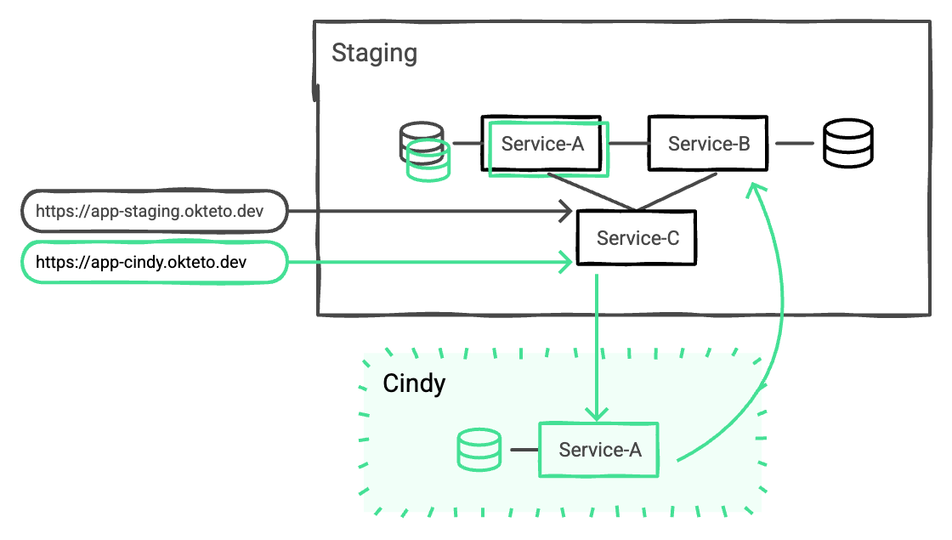Why Every Development Environment Eventually Falls Short. And Why That’s Okay.

Someone asked me a great question during a recent DevOps Toolkit livestream:
“How do you handle development environments? I’ve tried many tools, but they all fall short at some point.”
I'm sure this resonated with so many people tuning in.
Every dev environment solution does fall short eventually. And that’s not a sign they’re broken. It’s a sign the problem is harder (and more contextual) than most people realize.
Here are a few follow up thoughts on the subject of environment pitfalls with lessons we’ve learned from helping platform teams design their environment strategies over the years.
Dev environments shouldn’t “work out of the box”
There’s this widespread hope that dev environments will one day “just work” for everyone, in every architecture, with zero setup. That sounds amazing.
But it’s not realistic, at least not for teams building real-world software at scale.
At Okteto, we’ve been working on this problem for 6+ years. We’ve learned that dev environments aren’t something you install and forget. They’re a system you design, evolve, and constantly refine as your stack, team, and goals change.
Think in terms of systems, not just tools
One thing I see all the time: teams blame their dev environment tooling when what they’re really running into is a system-level tradeoff.
Let’s say you’re spinning up dozens or even hundreds of microservices and multiple databases for every developer. That can work. In fact, for some teams, it’s the best way forward. It’s simple, consistent, and isolates every dev experience.
But that model also comes with a literal cost. Running full replicas of complex systems for every developer can get expensive, especially as your team grows. And maintaining that level of scale, performance, and cleanup across environments becomes an operational challenge of its own.
The hard truth is that there is no universally right answer. Some teams prioritize speed and simplicity and are fine paying more to cloud providers. Others invest in alternate environment strategies like sharing infrastructure, selectively isolating services, or adopting stronger control policies to address budget and complexity needs over time.
Either path can work. But the point is that you need to be intentional about the tradeoffs you’re making and revisit them as your architecture evolves.
Local dev isn’t the future
I still hear people say, “I just want to run everything locally.” And look, I get it. I’ve been there too. There’s a certain comfort in having control of running things on your machine.
But I’ll be honest…local dev isn’t the future.
As architectures shift toward microservices, cloud-managed dependencies, and event-driven systems, local environments start breaking down. They're brittle, inconsistent, hard to replicate and impossible to scale in any realistic way.
“You can’t run a distributed monolith on your laptop. You can run it in the cloud and start fixing what’s broken.”
This is where the industry is headed. Modern cloud-native architectures aren’t designed to run locally. They’re designed for platforms like Kubernetes. Trying to emulate that locally, or stitching together remote services with a mostly-local workflow, becomes a fragile patchwork.
To truly test and iterate the way your app behaves in production, you need to run in Kubernetes not just redirect traffic to it. That’s how you close the gap between dev and prod, and build confidence into every commit.
Remote environments doesn’t always mean full replication
Another common misconception is that every developer always needs a fully isolated copy of the entire stack. But as your team grows and your architecture becomes more complex, replicating everything from databases, services, dependencies, for each individual developer can become slower, expensive to scale, and difficult to manage.
This is where flexibility of choice becomes important in your environment strategy. The ability to use the right environments for the right scenarios makes a big difference.
Many teams are adopting a hybrid approach that combines shared resources with selective isolation. At Okteto, we call this feature Divert. Instead of full replication for each developer, Divert allows you to create lightweight development environments that include only the services you are actively working on while leveraging an existing shared environment for all other microservices. At large scale, these environments become faster to spin up, more cost-efficient, and still gives you realistic, production-like context.

And of course, there are times when a fully replicated environment is the right choice, like end-to-end testing, or when debugging issues that span across multiple services. The key is having the flexibility to choose the right model for the job, and to shift as those jobs change.
“There’s no one-size-fits-all. The best environment strategies evolve with your architecture and your team’s needs.”
Optimize environments for the team, not just you
Here’s one of my hotter takes: sometimes, a dev environment feels like it’s slowing you down, but it’s actually speeding up the whole team.
And at the end of the day, that’s what matters.
If we’re optimizing for individual convenience, we end up with silos and snowflake setups. But if we’re optimizing for team throughput—collaboration, testing, deploy velocity—that’s where the real value shows up.
What’s the “right” dev environment strategy?
There isn’t one. That’s the truth.
What works for your team depends on your goals, your architecture, and your appetite for change. Some teams need isolated cloud environments. Others might get by with remote-local setups. Many land somewhere in between.
The most successful teams aren’t chasing the perfect dev environment. They’re building systems that adapt. They’re flexible. They revisit their environment strategy often and as their architecture changes. They’re not afraid to experiment, iterate, or even switch tools when the context demands it.
“The best dev environments aren’t perfect—they’re adaptable. You need something that grows with your architecture, not fights against it.”
Whether you’re wrangling a distributed monolith or just trying to spin up isolated previews, the goal isn’t perfection. It’s progress. Ultimately, it’s making sure your dev environment is working for your team, not slowing them down.
Final thought
If you’ve ever felt like your dev environment is falling short, you’re not alone. That’s exactly where every team starts.
What matters is whether you’re building a system that adapts. One that helps your team ship faster—not just work harder.
If you want to talk more about environments or developer experience, I’m always up for it. Reach out here →
